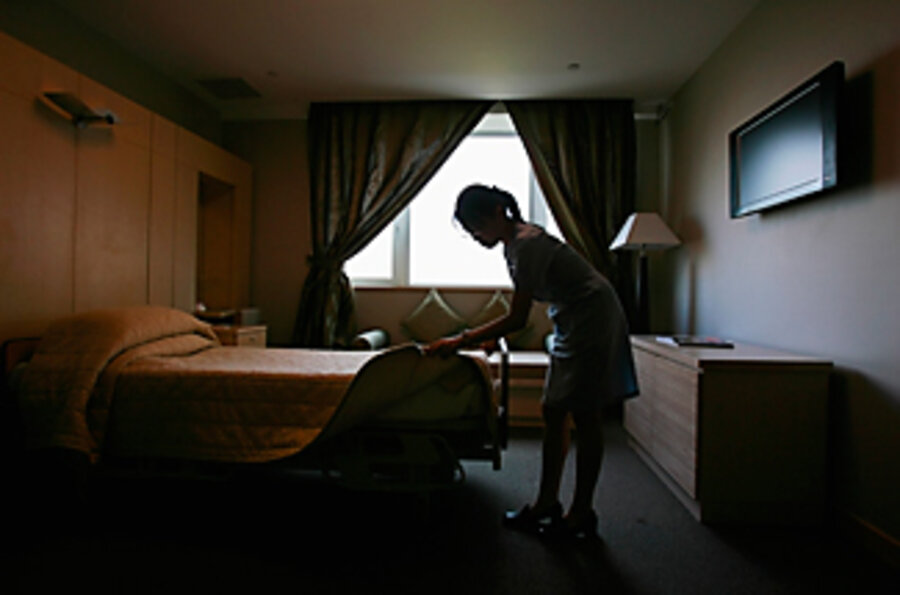In Singapore, shopping for a hospital
Loading...
| singapore
Shopping is a national pastime in this wealthy city-state and a bit of the retail culture is helping the government hold down hospital costs – at a time when much of the world is searching for an antidote to rampant healthcare spending.
One of Singapore's secrets: compulsory publication of the cost of hospital procedures. It has turned having a hip replacement into something similar to buying a pair of shoes.
Authorities require both public and private hospitals to post the average billing cost of operations and treatments for everything from strokes to fevers.
The figures can be detailed. They will list, for instance, how many appendectomies were performed in the "Class A ward" – a private air-conditioned room where the treatment is privately funded – at Singapore General Hospital. It will give the average length of stay for the operation and the median bill. It will also list the same details for those performed in the "Class C ward" – one with eight to 10 beds per room and no air conditioning.
The idea behind the system is to give consumers some choice as well as encourage competition among hospitals. Begun in 2003, the unusual scheme also makes the hospital billing structure transparent so authorities can monitor costs from year to year. Dr. Wong Chiang Yin, who has studied the system, estimates that it contributed to a 4 to 11 percent reduction in individual treatment costs between 2004 and 2005.
One drawback: The listings say nothing about quality of care, only pricing.
Still, the plan is one reason Singapore's healthcare system is often ranked as one of the more efficient in the world. Its total annual health expenditure represents 4 percent of gross domestic product (GDP) versus 15.3 percent in the US. Singaporeans enjoy good health, too. The country had the 12th highest life expectancy (81 years) and second lowest infant mortality rate in the world in 2008, according to the World Economic Forum's global competitiveness report.
As in the US, Singapore's healthcare system is largely privately funded, with about one-third financed by the government through tax revenues. At the core of the system, according to Phua Kai Hong, an associate professor at the National University of Singapore, is the Central Provident Fund (CPF) – a mandatory government pension account into which employees and employers contribute about one-third of workers' wages.
Part of the CPF money is earmarked for "Medisave," which covers the healthcare expenditures of about 85 percent of Singapore's population. Authorities estimate the fund currently has enough savings to pay for Singapore's total health bill for the next nine years. "Today, the average Medisave balances of Singaporeans are S$14,900 per person [US$10,500], enough to pay for 12 Class C hospitalizations," a Ministry of Health spokeswoman says.
For those unable to pay their medical bills, the government has set up a publicly financed "Medifund." Outside hospitals, private family doctors treat 80 percent of the population. A range of subsidized "polyclinics" and pro bono clinics for the very poor also exist. One of those working pro bono is Vincent Tan, who leaves his upmarket private practice near Singapore's famous shopping strip, Orchard Road, each day to volunteer at a practice run by his local temple. He says religious groups run free clinics with donated medicine.
"Quite a lot of us do it," he says. "The [patients] are usually elderly people in their 70s who don't have relatives and are not highly educated."
The Singaporean system has its flaws, though. One US-trained specialist says it deals well with outbreaks of disease that require a quick response, but less adeptly with conditions necessitating care over time. Nor is healthcare here immune from the price pressures affecting the world. Professor Phua, for one, estimates the aging population will increase health costs to between 6 and 8 percent of GDP by 2025.
Yet everything is relative. Peter Yeo, a retiree, spends half his time in Seattle and half his time here. He says a recent brain scan in Seattle cost him "10 times" what he had to pay at a hospital in Singapore.





